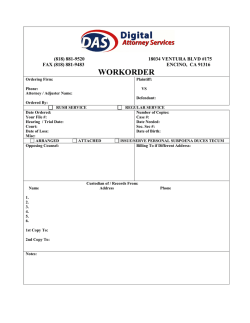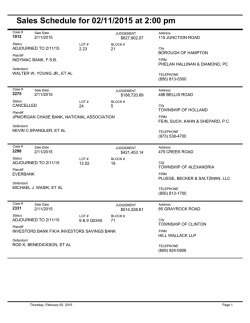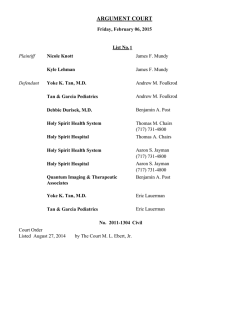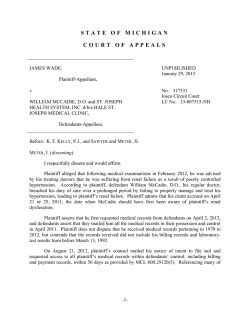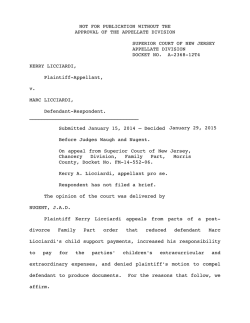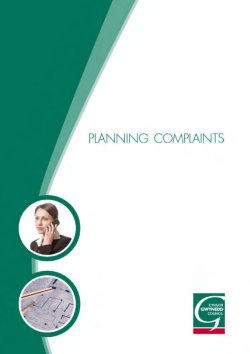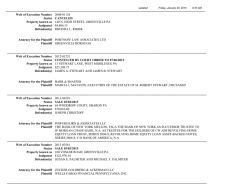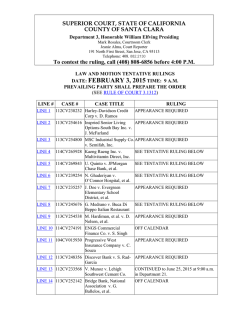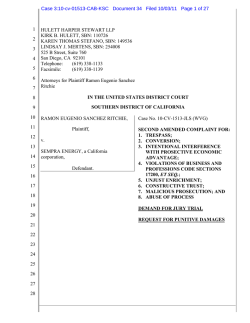
here - Personal Injury Lawyers
Personal Injury Litigation The Anatomy of a New York Personal Injury Lawsuit An eBook by Stuart DiMartini, Esq. 1325 Sixth Avenue, 27th Floor New York, NY 10019 212-5181532 dimartinilaw.com © 2015 Law Offices of Stuart DiMartini Introduction When you sustain a personal injury in an accident due to the fault of another person or entity, one of your first decisions is what lawyer to choose. There are many factors that go into that decision, including what is the lawyer’s experience, does the lawyer have a reputation in the community and does the lawyer practice exclusively in personal injury law. Once you have chosen a lawyer, it is the lawyer’s job to process your claim and, if necessary, commence the appropriate legal proceedings. Summons and Complaint In the New York civil courts, a personal injury matter is commenced by filing a Summons (or process) with the Clerk of the Court in whatever county the action is to be venued. Venue is the location of the court where the action is to be held. Proper venue is, generally, the county where any of the parties reside. In the case of an action against a governmental agency, proper venue is the county where the accident occurred. The Summons can be filed with a Complaint detailing the allegation against the alleged tortfeasor (wrongdoer), or by a Summons with Notice. In the case of the later, once process is served, the attorneys for the tortfeasor (defendant) can demand that a Complaint be served. Once the Summons is filed, the plaintiff (injured party) has 180 days to effectuate service of process. Service of process can be made in a variety of ways. These include personal service, substituted service, service by mail, and by other methods. Once service is made, the defendant has 20 days to Answer the Complaint. If service was made out of State, the time is increased to 30 days. The Complaint, as its name implies, tells the defendant what he did wrong and about the damages you sustained. Depending on the type of action that is being filed, the Complaint is required to include certain special allegations. The failure to include these allegations can make the complaint defective. This, among many other reasons, makes it prudent to seek the counsel of an experienced New York personal injury lawyer to assert your claim rather than attempting to go it alone. © 2015 Law Offices of Stuart DiMartini Claims against governmental agencies, motor vehicle accident claim and wrongful death claims all require specific allegations to be included in the Complaint for the Complaint to be viable. If you have a spouse, they have a separate cause of action that should be included in the complaint. This is known as a loss of consortium claim. A personal injury attorney will take these considerations into mind when drafting the Complaint as well as many other considerations. Many times, the attorneys for the defendant will ask for a Stipulation agreeing to extend their time to answer the Complaint. These Stipulations are routinely agreed to. It is not unusual for the insurance company for the tortfeasor to assign defense counsel to the claim at the 11th hour, leaving the defense counsel with little or no time to Answer the Complaint. Should the defendant not Answer the Complaint in a timely manner, plaintiff may move the Court for a default judgment. Plaintiff has one year from the time service was completed to seek a default judgment by making an application to the court. Answer An Answer is interposed when defense counsel serves it upon plaintiff’s lawyers. This is normally done by regular mail. The Answer must deny, admit or deny knowledge of each of the allegations contained in the Complaint. Merely denying every allegation of the Complaint regardless of its veracity will make the Answer to be considered a shame pleading and not an Answer at all. Competent defense lawyers will go through the allegations of the Complaint and make the appropriate responses. When legal issues are raised in the Complaint, the answer may allege that it will defer legal questions to the discretion of the court. The Answer is the place where defendant may raise its affirmative defenses, counterclaim or crossclaim. Affirmative defenses can be procedural or substantive. A procedural affirmative defense can include a statute of limitations defense i.e. that the time suit was not timely filed, or the failure to properly © 2015 Law Offices of Stuart DiMartini effectuate service of process. Substantive affirmative defenses can include such defenses as a failure to use a seat-belt, comparative negligence i.e. that plaintiff was partly at fault for the accident, collateral source (that plaintiff’s medical expenses were paid by a third-party; plaintiff is not allowed a double-recovery), among other defenses. Some affirmative defenses, such as collateral source, are jurisdictional, meaning if they are not raised in the Answer they are waived. A counterclaim is whereby the defendant asserts a direct claim against the plaintiff. A crossclaim is whereby a claim is asserted against either a co-plaintiff or by a co-defendant. When the Complaint is verified, then the answer and all subsequent pleadings must also be verified. If the party resides outside the county in which the representing attorney maintains his/her office, then the pleadings may be verified by the attorney. Otherwise, the party itself must verify the pleading. Discovery Once an Answer has been interposed, the lawsuit enters the discovery stage. This is where each side get to learn the details about the claim and the defenses being asserted. Normally, the defendant serves along with its Answer various discovery items, including a Demand for a Bill of Particulars and a Notice to Produce. Plaintiff’s counsel has a limited time to respond to these items, otherwise the defendant can make a motion to the court seeking to compel production or having the complaint stricken. Likewise, plaintiff will serve a Demand for a Bill of Particulars as to the affirmative defenses alleged and a Notice to Produce. It is also at this time where the plaintiff will, usually, petition the court for its first conference, called a Preliminary Conference. The Bill of Particulars is like a road map of the case. It will particularize or detail the allegations of the claim, including alleging in detail the acts or omissions of negligence on the part of the defendant, the injuries alleged, time lost from work or school, lost wages, medical care and treatment rendered and medical expenses. The Notices to Produce or Demands for Discovery and Inspection will request that the opposing party © 2015 Law Offices of Stuart DiMartini produce document relating to the claim: such as medical reports; authorizations to obtain medical, school, employment, and income tax records; and other items deemed relevant by the party. In the New York City civil courts, it can take three months or more before the case is called for its preliminary conference. At the preliminary conference discovery deadlines are set, including dates for the examination before trail of the parties and for an examination of the plaintiff by a doctor of the defendant’s choosing. The court will also schedule a Compliance Conference at this time where the parties will be required to return to court and explain their progress, as well as setting a date for plaintiff to file a Note of Issue (to be discussed later). An examination before trial is when a party’s lawyer asks questions under oath of an opposing party before a court stenographer. All parties to the action are deposed in this manner. The lawyers will attempt to illicit as much information and facts surrounding the matter as they deem relevant. Any inappropriate questions can be referred to the presiding judge for a ruling. The judge will decide whether the question is appropriate and therefore should be answered. If any of the parties are dilatory in complying with the court’s order, the affected party may more the court to compel same or to strike the pleading. If there are discovery issues or discovery has not been completed as directed by the court at the Preliminary Conference, those issues will be addressed by the court at the Compliance Conference. At this time, the court will issue another order directing what discovery should take place and when. It may also extend plaintiff’s time to file a Note of Issue. Although the New York State Court System is known as the Unified Court System, many county courts have unique procedures that can differ from county to county. For the most part, at the Compliance Conference, the court will schedule another conference date for the parties to appear and to update the court on the status of discovery. The discovery process is extremely important to all sides, not only to learn the strengths and weaknesses of the case, but in so doing it can enhance early settlement possibilities. Of course, settlements can be agreed to at any time, but once discovery is complete, the parties are better able to evaluate their risk-to-reward ration of going forward. © 2015 Law Offices of Stuart DiMartini Note of Issue Once discovery is complete, plaintiff is ordered by the court to file a Note of Issue and Certificate of Readiness. This document informs the court that all discovery is complete and that the case is trial ready. It is here that the plaintiff can demand a trial by jury. If the plaintiff is elderly, plaintiff can request a trial preference whereby the case will be called for trial faster that waiting on the normal trial calendar. Trial Once the case is trial ready, it is placed on the trial calendar and given a calendar number. In most of the boroughs of New York City, it can take upwards of 13 months before the case is called for trial. Even with that, the case will not normally be sent out for trial on the first call. During this time, the court may schedule a settlement conference to attempt to resolve the matter and/or a pre-trial conference to discuss trial issues and scheduling. At trial, the parties will call their respective witnesses. It is plaintiff’s burden to prove that the defendant was negligent and therefore a proximate cause of the accident and resulting injuries. Testimony from a doctor is necessary to establish the injuries plaintiff sustained and their causality to the accident. Other experts may be needed depending on the type of case being litigated. If the case involved a trip and fall on a defective sidewalk, for example, plaintiff may call an engineer to establish that the sidewalk was not up to code. In a wrongful death case, plaintiff may call an economist to establish that economic worth of the loss of a decedent’s life. Likewise, defense counsel will call experts to refute the damages sustained and/or liability for causing the accident. Once the parties rest, the judge will instruct the jury on the law of the case. The jury will then be set to deliberate and decide liability and the amount of damages, if any. If either party believes there was an error committed by the judge during the trial or that the verdict was excessive, they have the right to appeal to the Appellate Division of the Supreme Court of the State of New © 2015 Law Offices of Stuart DiMartini York. Conclusion Personal injury litigation in the civil courts of the State of New York is a complex, time consuming and a costly endeavor. Anyone injured in a New York accident that was due to the fault of another person or entity, should, as soon as possible, consult with an experienced personal injury lawyer. © 2015 Law Offices of Stuart DiMartini
© Copyright 2025
